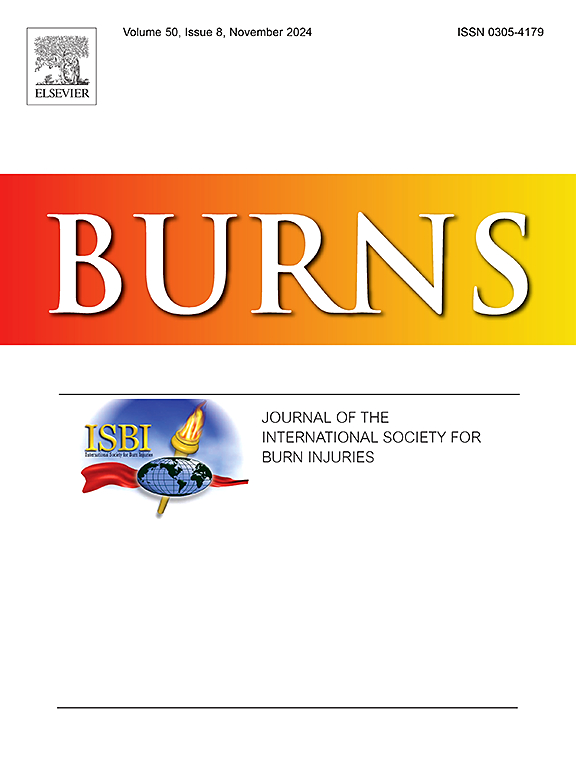Posttraumatic growth of Chinese burn patients: Prevalence, comparison, and predictors
IF 2.9
3区 医学
Q2 CRITICAL CARE MEDICINE
引用次数: 0
Abstract
Objective
The positive psychological transformation following burns, in contrast to the well-documented negative impacts, remains under-researched, particularly in lower-middle income countries (LMICs). Existing studies predominantly focus on high-income countries. This study examines the prevalence of posttraumatic growth (PTG) among Chinese adult burn patients, explores cross-cultural differences in PTG manifestation, and identifies predictors of PTG in this population.
Methods
We conducted a cross-sectional analysis of 132 adult patients recruited from two burn units in China. Assessments included the Posttraumatic Growth Inventory, Depression, Anxiety, and Stress Scales-21, Posttraumatic Stress Disorder Checklist, and the Multidimensional Scale of Perceived Social Support. Univariate and multivariate models were employed to evaluate potential influencing factors.
Results
The mean PTG score among the Chinese burn patients was 56.7 ± 25.0. Within this cohort, 46 % and 74 % of patients scored above the moderate level, depending on thresholds of 63 and 48, respectively. Model analysis identified significant positive associations between PTG and both increased social support and higher levels of depression. Additionally, time since injury and higher educational attainment were noteworthy predictors, with effects approaching statistical significance.
Conclusion
This study is the first to present data on both negative and positive psychological conditions among Chinese burn patients, revealing their interrelationship. The findings confirm the applicability of PTG models in LMICs and suggest cross-cultural differences in PTG compared to high-income nations. Increased social support and higher depression levels were significantly associated with PTG, while time since injury and educational attainment showed notable, albeit marginal, predictive value. These insights contribute to a valuable understanding of psychological growth pathways in LMICs.
中国烧伤患者的创伤后生长:患病率、比较和预测因素
与文献记载的负面影响相比,烧伤后的积极心理转变仍有待研究,特别是在中低收入国家(LMICs)。现有的研究主要集中在高收入国家。本研究调查了中国成人烧伤患者创伤后生长(PTG)的患病率,探讨了PTG表现的跨文化差异,并确定了该人群中PTG的预测因素。方法我们对来自中国两个烧伤单位的132名成人患者进行了横断面分析。评估包括创伤后成长量表、抑郁、焦虑和压力量表-21、创伤后应激障碍检查表和感知社会支持多维量表。采用单因素和多因素模型评价潜在影响因素。结果中国烧伤患者PTG评分平均值为56.7 ± 25.0。在这个队列中,46 %和74 %的患者得分高于中等水平,分别取决于阈值63和48。模型分析表明,PTG与增加的社会支持和更高的抑郁水平之间存在显著的正相关。此外,受伤时间和受教育程度是值得注意的预测因素,其影响接近统计学意义。结论本研究首次提供了中国烧伤患者消极和积极心理状态的数据,揭示了它们之间的相互关系。研究结果证实了PTG模型在中低收入国家的适用性,并表明PTG与高收入国家相比存在跨文化差异。增加的社会支持和更高的抑郁水平与PTG显著相关,而受伤后的时间和受教育程度显示出显著的预测价值,尽管是边际的。这些见解有助于对中低收入国家的心理成长途径有价值的理解。
本文章由计算机程序翻译,如有差异,请以英文原文为准。
求助全文
约1分钟内获得全文
求助全文
来源期刊

Burns
医学-皮肤病学
CiteScore
4.50
自引率
18.50%
发文量
304
审稿时长
72 days
期刊介绍:
Burns aims to foster the exchange of information among all engaged in preventing and treating the effects of burns. The journal focuses on clinical, scientific and social aspects of these injuries and covers the prevention of the injury, the epidemiology of such injuries and all aspects of treatment including development of new techniques and technologies and verification of existing ones. Regular features include clinical and scientific papers, state of the art reviews and descriptions of burn-care in practice.
Topics covered by Burns include: the effects of smoke on man and animals, their tissues and cells; the responses to and treatment of patients and animals with chemical injuries to the skin; the biological and clinical effects of cold injuries; surgical techniques which are, or may be relevant to the treatment of burned patients during the acute or reconstructive phase following injury; well controlled laboratory studies of the effectiveness of anti-microbial agents on infection and new materials on scarring and healing; inflammatory responses to injury, effectiveness of related agents and other compounds used to modify the physiological and cellular responses to the injury; experimental studies of burns and the outcome of burn wound healing; regenerative medicine concerning the skin.
 求助内容:
求助内容: 应助结果提醒方式:
应助结果提醒方式:


